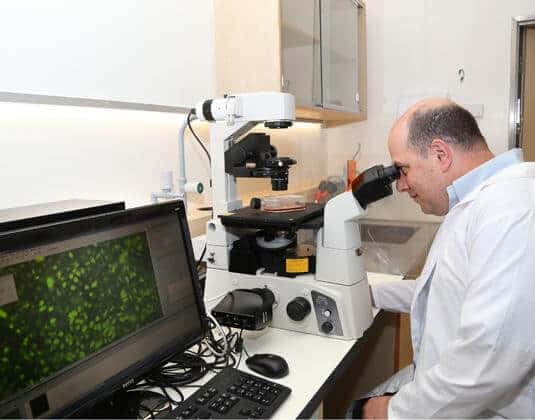Melanoma and Skin Cancer Treatment
Melanoma and Skin Cancer Treatment at Sheba
Offering cutting-edge medicine with a personal touch, Sheba tailored each patient a holistic treatment plan by leveraging the expertise of an interdisciplinary team of dermatologists, medical oncologists, pathologists, surgeons, and researchers. In this manner, we ensure our patients the best possible treatment outcomes.
The Ella Lemelbaum Institute for Immuno-Oncology is dedicated to world-class melanoma treatment and continuous research into this widespread disease. Our top-tier staff, including experienced clinicians, researchers, and nurses, strives to provide patients and their families with total integrative care. To that end, the Ella Institute works with some of the leading melanoma treatment centers around the world, including the U.S. National Institutes of Health (NIH).
We are proud to provide the absolute latest in melanoma treatment, including advanced immunotherapy techniques, and offer patients the opportunity to participate in ongoing clinical studies.

Overview
Skin Cancer
The most prevalent type of cancer worldwide, skin cancer is caused by unrepaired DNA damage to skin cells, which triggers mutations (genetic defects). These mutations spark abnormal skin cells to multiply rapidly, forming malignant tumors that can spread to other parts of the body. Skin cell damage is largely caused by excessive exposure to ultraviolet (UV) rays, and 90 percent of non-melanoma skin cancers are linked to exposure to UV radiation.
The most common form of skin cancer is basal cell carcinoma, followed by squamous cell carcinoma and melanoma.
Melanoma
Melanoma accounts for less than one percent of skin cancers, yet it is one of the most aggressive, responsible for the majority of skin cancer mortalities (about 80%). It develops in melanocytes, the cells responsible for pigment production in the skin, and can form in any area of skin. Approximately 1,800 people are diagnosed with melanoma in Israel every year.
When detected early and while it is still localized, melanoma can almost always be successfully treated.

Types
| 1
Superficial spreading melanoma. This type accounts for approximately 70% of melanomas, usually developing from an existing mole.
| 2
Lentigo maligna melanoma. This type of melanoma usually manifests in the elderly. It most commonly begins on the face, ears, arms, and other sun-exposed areas.
| 3
Nodular melanoma. About 15% of melanomas fall into this category. It often appears rapidly as a bump on the skin, which in most cases is black, but may also be pink or red.
| 4
Acral lentiginous melanoma. This type of melanoma develops on the palms of the hands, soles of the feet, or under the nail bed. People with darker skin may be more susceptible to it. Acral lentiginous melanoma is not related to sun exposure.
Stages
| Stage 0
In stage 0 melanoma, the malignant tumor is still confined to the upper layer of the skin. The melanoma is in situ (which means “in place” in Latin), and there is no evidence that the cancer has spread to the lymph nodes or distant organs (metastasis).
| Stage 1
In stage 1 melanoma, there are cancer cells in both the epidermis and dermis, and there is no evidence that cancer has spread to lymph nodes or distant sites (metastasis).
| Stage 2
Stage 2 melanoma is defined by tumor thickness and ulceration. There are cancer cells in both the epidermis and dermis, but there is no evidence that the cancer has spread to the lymph nodes or distant organs (metastasis).
| Stage 3
Stage 3 melanoma is defined by the level of lymph node involvement and ulceration. In stage 3 melanoma, cancer has spread to one or more regional lymph nodes or developed a deposit of melanoma in the skin or dermis along the lymphatic vessels before reaching a lymph node. This is called an in-transit or satellite metastasis. There must, however, be no evidence that the cancer has spread to distant organs (metastasis).
| Stage 4
In stage 4 melanoma, the cancer has spread beyond the original tumor site and regional lymph nodes to more distant areas of the body. The most common sites of metastasis are distant skin and lymph nodes, followed by the lungs, liver, brain, bone and/or intestines.
Prevention
Most skin cancers are preventable. To protect yourself, follow the tips below:
- Avoiding the sun at its strongest helps you prevent sunburns and suntans that cause skin damage and increase your risk of developing skin cancer. Accumulated sun exposure over time can also cause skin cancer.
- Apply sunscreen year-round. Sunscreen doesn’t filter out all harmful UV radiation, but can play a crucial role in an overall skin protection regimen.
- Wear protective clothing. As sunscreen doesn’t provide complete protection from UV rays, it is recommended to cover your skin with dark, tightly woven clothing that protects your arms and legs, and a broad-brimmed hat, which provides more protection than a baseball cap or visor.
- Don’t forget sunglasses. Look for those that block both types of UV radiation — UVA and UVB.
- Avoid tanning beds. Lights used in tanning beds emit UV rays and can increase your risk of skin cancer.
- Examine your skin often for new growth or changes in moles, freckles, bumps, and birthmarks, and report any changes to your doctor.

Melanoma Indicative Moles
| A
is for asymmetrical shape. Look for moles with irregular shapes, such as two very different-looking halves.
| B
is for irregular borders. Look for moles with irregular, notched, or scalloped borders — characteristics of melanomas.
| C
is for changes in color. Look for growths that have many colors or an uneven distribution of color.
| D
is for diameter. Look for new growth in a mole larger than 1/4 inch (about 6 millimeters).
| E
is for evolving. Look for changes over time, such as a mole that grows in size or changes color or shape. Moles may also evolve to develop new signs and symptoms, such as new itchiness or bleeding.
Treatment
Surgery
The main treatment for melanoma is surgical removal of the primary melanoma on the skin. Surgical procedures will vary depending on the thickness of the melanoma. Typically, doctors remove the tumor, the tissue found under the skin, and some surrounding healthy tissue, called a margin, to ensure that no cancer cells remain.
Targeted Therapy
Melanoma targeted therapies include:
- BRAF inhibitors: Mutations in the BRAF gene cause melanoma cells to produce proteins that help cancer cells grow. About half of melanoma skin cancers have the BRAF mutation. BRAF inhibitors include vemurafenib, dabrafenib, and encorafenib.
- MEK inhibitors: The MEK protein works with the BRAF gene. Medications targeting the MEK protein can treat melanomas with BRAF mutations. MEK inhibitors include trametinib, cobimetinib, and binimetinib.
Immunotherapy
- Immune Checkpoint Inhibitors
- Adoptive Cell Therapy
Immune checkpoint inhibitors, specifically anti-CTLA4 and anti-PD-1 antibodies, have revolutionized the management of many cancers, particularly advanced melanoma, for which tumor regression and long-term durable cancer control is possible in nearly 50% of patients, compared with less than 10% historically.
Adoptive cell transfer therapy, or ACT, includes several different types of immunotherapy. All of these approaches involve growing large numbers of immune cells in a lab and introducing them into the body to fight cancer. Sometimes, immune cells that naturally recognize melanoma are used, while in other cases, cells are modified to make them recognize and kill the melanoma cells.
One particularly promising ACT is tumor-infiltrating lymphocyte therapy (TIL): a procedure for patients with malignant metastatic melanoma with very encouraging results. The therapy involves removing T-cells found in the tumor itself, then multiplying and reintroducing them to the patient’s body. Sheba is a recognized global leader in TIL, which is offered in a limited number of healthcare institutions worldwide.

Our Staff



Request a consultation
Sheba Medical Center provides innovative, personalized medical care to patients from around the world. We are the largest, most comprehensive hospital in the Middle East and dedicated to providing advanced and compassionate medicine for everyone.
We welcome all cases, including the rarest and the most challenging. Our medical teams collaborate to provide the best possible health outcomes. From your initial inquiry through the long-term follow-up care, we are here for you.
Request a consultation and a Sheba Case Manager will contact you shortly:
